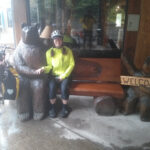Winter cycling often conjures images of icy roads and treacherous conditions, deterring even the most dedicated riders. However, a revolution in tire technology has transformed winter biking into an exhilarating and accessible sport: fat biking. Forget the sluggish rides and constant battles for traction you might imagine. The secret to conquering snow and ice lies in the very foundation of these bikes – Fat Bike Tires.
Many cyclists, like myself, once held misconceptions about winter fat biking. Visions of slow, cumbersome rides and the Iditabike challenge might spring to mind. Before experiencing it firsthand, I pictured snow biking as an extreme endurance test, far removed from the joy of summer trails. Living in Park City, Utah, surrounded by groomed trails, I remained skeptical. Could snow biking truly rival the thrill of mountain biking on dirt? Could it possibly be as enjoyable as skiing or snowboarding? The answer, emphatically, is yes. Fat biking, when equipped with the right fat bike tires, opens up a new dimension of cycling, a discipline as captivating as XC, downhill, or gravel riding.
Let’s dispel the myths surrounding snow biking, starting with speed. While not as rapid as summer trail riding, fat biking is far from slow, especially when fat bike tires meet perfectly packed snow. The ever-changing snow conditions are a unique and fascinating aspect of this sport. When conditions are ideal, snow trails become playgrounds comparable to dirt tracks, offering a distinct riding sensation. The way fat bike tires grip the snow, how you distribute weight, and brake into turns creates a unique and engaging experience. And the best part? Crashing becomes a low-stakes affair. The forgiving snow allows you to push your limits, experiment with the bike and fat bike tires, and truly test the terrain without fear of serious consequences.
Choosing the right gear is paramount for winter biking, and clothing layers are crucial for managing temperature fluctuations. The goal is to stay warm without overheating, venting on climbs and insulating for descents. Modern technical fabrics make this balance achievable.
Terrain variety is another advantage. While some trails are shared with Nordic skiers, many areas, like Park City, offer dedicated groomed singletrack for bikers and hikers. These trails transform into bobsled runs with sufficient snow. Interestingly, snow biking conditions often improve as ski conditions worsen. Hard-packed groomers for skiing become ideal surfaces for fat bike tires, leading me to swap ski slopes for snow trails on many days.
Like any specialized cycling discipline, winter fat biking relies heavily on appropriate equipment. My setup revolves around a Trek Farley 9.6 fat bike, a model that highlights the evolution of fat bike tires and technology.
The Trek Farley 9.6 exemplifies the modern approach to fat bikes. While the 26-inch wheel was the original standard for fat bike tires, progressive designs are now embracing 27.5-inch wheels, as seen on Trek’s flagship Farley 9.6. The larger diameter of 27.5-inch fat bike tires provides a greater contact patch, reducing rolling resistance. This allows for slightly narrower tire widths, typically 4.5 inches compared to the older 4.8-inch standard, without sacrificing floatation or traction.
The heart of the Farley 9.6 is its OCLV carbon fiber frame and fork, contributing to a remarkably light and stiff feel. Suspension is unnecessary on snow, as the forgiving surface, combined with the cushioning of fat bike tires run at approximately eight PSI, effectively absorbs bumps and irregularities. Despite their substantial size, fat bikes like the Farley 9.6 are surprisingly nimble and light, weighing in around 28 pounds with pedals and a dropper post. They possess a deceptive agility that belies their robust appearance, largely thanks to advancements in frame design and fat bike tire technology.
The drivetrain on a fat bike needs to be reliable and functional, and the SRAM NX Eagle on the Farley 9.6 (upgraded to GX Eagle in later models) fits the bill. Snow biking is surprisingly low-maintenance on components, as the absence of dirt minimizes wear and tear. Keeping the chain clean and lubricated is usually sufficient. While Strava times are not a primary concern in snow, gear range remains crucial. Soft snow conditions often demand high cadence pedaling, emphasizing the importance of a wide gear range to efficiently utilize the traction of fat bike tires.
Upgrades can further enhance the snow biking experience. A dropper post, now standard on newer Farley 9.6 models, is essential for navigating snowy terrain. Lowering the center of gravity improves stability and control, maximizing the effectiveness of fat bike tires when cornering on shifting snow. The FSA Flowtron dropper post is a reliable and cost-effective option that performs well in freezing temperatures. Similarly, swapping the stock aluminum handlebar for a carbon riser bar, like the FSA Gradient Carbon 35, reduces weight and enhances handling, allowing for more precise control over the fat bike tires.
Pedal choice is a matter of personal preference for snow biking. While flat pedals are popular due to frequent dismounts and less emphasis on pedaling efficiency, clipless pedals offer enhanced control. The Crank Brothers Mallet E LS pedals provide a good balance, offering a solid platform and reliable performance in wet conditions. Their “egg beater” cleat system excels in snowy and wet environments, and adjustable traction pins further secure shoe placement, whether clipped in or not, optimizing power transfer to the fat bike tires.
However, the most critical component for snow biking performance is undoubtedly the tires. The choice of fat bike tires dictates how a bike handles in snow. The Farley comes with Bontrager Barbegazi Team Issue 4.5-inch tires, excellent for rear traction with their square knobs. However, for improved front-end grip, especially crucial for cornering, swapping to a 45NRTH Dillinger 4.5-inch Studded tire is a game-changer. The Dillinger features angled center treads and “slice-y” side knobs, enhancing cornering stability, the most challenging aspect of snow biking. The studded version, equipped with 252 concave aluminum carbide studs, provides maximum front-tire grip, essential for icy conditions and boosting confidence in challenging winter terrains. For optimal control and safety, especially in variable winter conditions, investing in high-quality studded fat bike tires is highly recommended.
Trek’s Farley lineup offers various models catering to different budgets, all based on 27.5-inch platforms and providing similar riding experiences. Regardless of the specific model, the consistent factor for enjoyable winter riding remains the fat bike tires.
Transporting fat bikes requires consideration due to their size. The Thule T2 Pro XT receiver rack is designed to accommodate bikes with fat bike tires up to five inches wide, featuring adjustable trays and straps to secure these oversized wheels. Accessories like the Thule Access further enhance convenience, allowing the rack to swing away for vehicle access, particularly useful for vehicles like Jeep Wranglers with rear-mounted spare tires.
Appropriate winter cycling apparel is equally important for comfort and performance. Assos Bonka EVO Bib Tights offer warmth, comfort, and a performance fit, utilizing strategic fabric placement for insulation and breathability. The 45NRTH Naughtvind Shell Pants, designed as an over-layer for bib tights, provide essential protection from the elements, with features like vents and reinforced areas specifically tailored for winter biking.
Shimano MW7 winter bike shoes provide insulated, waterproof protection, crucial for keeping feet warm and dry in snow and cold. Pearl Izumi Interval AmFIB Jacket offers excellent warmth-to-weight ratio and ventilation, suitable for a wide range of winter temperatures when combined with appropriate base layers. Accessories like the 45NRTH Baklava, Assos Winter Cap, and Pearl Izumi AmFIB Lobster Gel Gloves further enhance comfort in cold conditions.
In conclusion, winter fat biking is a transformative cycling experience, far removed from the initial misconceptions of sluggishness and discomfort. The key to unlocking the joy of snow riding lies in embracing the right equipment, most importantly, fat bike tires. These specialized tires provide the necessary traction, floatation, and control to conquer snow and ice, turning winter trails into playgrounds. With advancements in bike technology and apparel, fat biking has become an accessible and exhilarating way to extend your cycling season and experience the unique beauty of winter landscapes.


